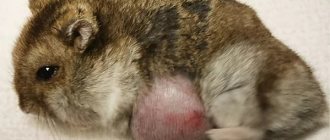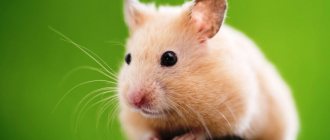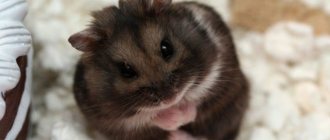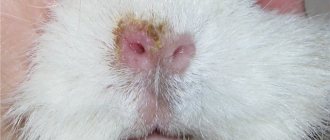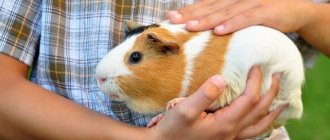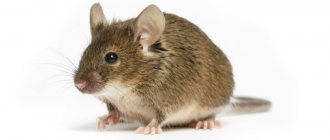Origin and habitat
The first mention of Djungarians dates back to the end of the 18th century. The German scientist and traveler Pallas described the animal that he encountered on the territory of the Dzungarian region (modern eastern Kazakhstan), initially calling it the Zungarian mouse due to its small size.
In the wild, hamsters prefer to live in deserts, dry steppes, and much less often in forest-steppes.
Their habitat is:
The domestication of wild hamsters occurred in the 20th century. People fell in love with tiny pets, thanks to which the dwarfs spread throughout Eurasia. They can be found much less often in America.
Homeland of the Djungarians
Zoologist P. Pallas was the first to discover and describe the Djungarian hamster. This happened in 1773, when the scientist made an expedition through the territory corresponding to modern East Kazakhstan. At that time, the region was part of Dzungaria, or the Oirat Khanate.
The specific name of the animal has survived to this day. It reflects the historical name of the area where the hamster was encountered. The territory of Dzungaria in the modern sense is an area in northwestern China. Djungarians have never lived here. Their real homeland is the steppes in eastern Kazakhstan.
Sounds that the Djungarian hamster makes:
Colors of Djungarian hamsters
Domesticated rodents, as a result of selection, have acquired a variety of colors, the features of which are a dark stripe and interspersed with light spots on the back, an almost white abdomen and paws. There are main types of colors of Djungarian hamsters.
Standard
The standard color resembles nature. In the wild, it helps animals camouflage against the background of sand and steppe plants. The standard calls for brownish-gray fur on the back and a dark or black stripe from head to tail. The abdomen and paws are white or light gray.
The standard color of the Djungarian hamster is natural.
Albino
Albinos have white fur and pink skin. They have red or pink eyes.
Sapphire
This coloration is characterized by a gray-blue back and a much lighter, to white, belly and paws.
The sapphire-colored hamster has a characteristic gray-blue back.
Pearl
Pearl hamsters have matte white fur with gray patches. Among them there are individuals with a uniform milky color without a stripe on the back.
Mandarin
It is a red color with a brown stripe on the back, with lighter legs and belly.
Mandarin is a red color with light legs and belly.
Genetics and combination of genes of Djungarian hamsters.
Due to the appearance in Russia of a fairly large number of Djungarian hamsters of various colored colors, a need arose to systematize knowledge about their simple colors and complex colors obtained by combining genes from mating two colored hamsters or a colored hamster and a standard-colored hamster.
Appearance of a standard Djungarian hamster ( normal, natural
) color is well known to everyone - grayish-brownish fur with black ticking at the ends of the hairs, the ticking forms the border of the arches on the sides and the dorsal stripe in the middle of the back, turning into a characteristic “diamond” on the animal’s face.
The number of color variations is more significant.
Simple (or basic) can be conditionally called those colors where for the manifestation of color in the phenotype (external appearance) there is only 1 color gene - tangerine (Mama), pearl (Pepe) and sapphire (dd).
We are considering the colors currently available in Russia.
It should be noted that tangerine and pearl are dominant genes, and sapphire is a recessive gene, i.e. For its manifestation in the phenotype of the offspring, this gene must be present in both parents.
We often hear the question “Why is this color called that? I would call him this or that..."
The fact is that the name of the color from the new mutation is given by the breeder who first bred it and fixed it.
In children's fur, the colors have a slightly different shade than in its adult state - tangerine has a bright orange color, pearl shimmers white and pink, and sapphire has bluish fur.
At the age of about 1-1.5 months, hamsters change into adult fur and their color changes slightly.
This is even more pronounced in hamsters with complex colors, from a combination of 2 or more colored colors at the same time - blue / sapphire pearl (Pepedd), blue mandarin / camel (Mamadd), tangerine pearl (MamaPepe) and pearl camel (PepeMamadd).
When breeding colored hamsters, you must always remember some of their breeding features.
Thus, you cannot breed two tangerine-colored hamsters together, since this gene is lethal.
Regarding the mating of two pearl animals, the opinions of European colleagues differed - the Dutch consider it lethal and do not recommend such matings, and Finnish colleagues advise such matings specifically to lighten the ticking of too heavily ticked (“dirty”) pearls. They agree on one thing - homozygous non-viable fetuses remain in the female’s uterus without development and, taking up space there, contribute to the reduction of offspring in broods and her further infertility. In other words, you can breed two pearls, but be prepared for the fact that your female will gradually produce fewer and fewer hamsters. But on the other hand, if we take competent breeding with respect to the beginning of the female’s marriageable age and the end of her maternal career, and the necessary intervals for her recovery between bearing and feeding two successive litters, then more than 2-4 matings per 1 breeding female should not happen.
When interacting sapphire color with others (blue pearl, camel, pearl camel), one must keep in mind that the sapphire gene lightens the overall tone of the dominant color. Sapphire is a brightened standard. If the sapphire color appears in a color of another color, then it gives a sapphire tint. Due to this, the ticking in the case of blue pearls will not be black (as with regular pearls), but lighter – a sapphire hue. But in the case of a camel or pearl camel, the ticking will be reddish-brown (like a tangerine), and the influence of the sapphire color lightens the overall tone of the entire color of the animal as a whole.
When pearl and tangerine are combined, the animal will be mostly white with a reddish-brown dorsal stripe.
In the pearl camel, the dorsal stripe has an even lighter appearance due to the lightening of the ticking with sapphire color.
How are such interesting and complex combinations of genes formed?
When mating a colored jungarik of a dominant color with a standard partner, we will get approximately half standard and half colored
When mating a sapphire (recessive) color and a standard hamster, we will get a full litter of phenotypically (externally) standard hamsters carrying the sapphire gene.
The situation will be similar when mating with dominant colors. The children will turn out to be part of the brood colored and carrying sapphire, and part of the brood standards will be carriers of sapphire.
But when mating a colored hamster carrying a recessive gene with a hamster similar to it, the number of possible colors in the offspring increases.
We divide the genes into pairs and build a calculation table:
We add up the results obtained, add the missing “dummies” to the dominant genes, cross out complete dominant and recessive “dummies”.
Thus, we received as probable descendants simple “single” colors - standard and sapphire carrier standard; pearls and sapphire carrier pearls; mandarin and sapphire carrier mandarin; as well as complex “double” colors - tangerine pearl and tangerine pearl-carrier sapphire blue pearl and blue tangerine/camel; as well as a “triple” color – pearl camel. Other variants of gene combinations are calculated using the same principle:
More complex multicomponent circuits are built and calculated using the same principle.
Table of colors of Djungarian hamsters available in Russia.
Imported to Russia in the form of a wearable gene.
Not available in Russia.
The article uses photos of Maria Kryukova and Martin Braak (Holland).
Source
Features of white color
White dzhungarikas are no different from their relatives, except for their pearl coloring. Often there is no stripe at all on the back of these hamsters. In such cases, the animal is completely dull and milky. Pearly white hamsters are bred by breeders and are loved by breeders.
Albinos, due to a gene mutation, lack the pigment melanin, which is responsible for the color of their skin and coat. Their eyes are red because, in the absence of pigment, the blood vessels in the cornea become clearly visible. The lack of melanin negatively affects the health of hamsters.
The main problems of albinos:
The cage with a special pet should be placed in a shaded place, protecting the animal as much as possible from contact with direct sunlight.
Preparing a rodent for examination
Choose a time when the dwarf is calm or sleepy. At this point, he will be less aggressive and will not try to break free. Be sure to pet, caress, and give your pet a tasty treat.
Place the jungarik in your left palm. Then, using the thumb and index finger on your right hand, gently grab the fold of skin between your shoulder blades. This will help secure the rodent so that it does not spin around and bite its owner. Pulling the skin and lifting the pet in this position is prohibited. Carefully turn the animal onto its back. It is ready for inspection.
Lifestyle of Djungarian hamsters
Adult Djungarians prefer to live alone. They are characterized by territorial division.
Hamsters' burrows are spacious, up to 1 m deep, with many branches and chambers. Separate rooms are equipped for sleeping, storing supplies, and toilets.
Hamsters sleep during the day and forage for food at dusk and at night.
The basis of the diet is:
A hamster can walk several kilometers in search of food, and stores about 20 kg of food for the winter. Djungarians carry food in subcutaneous bags on the sides of the body.
Adult dwarfs live alone.
This species of the hamster family does not hibernate. In winter, the coat color becomes lighter and blends into the snowy landscape. By cold weather, the hamster's body acquires subcutaneous fat.
Rodent character
Djungarian hamsters are militant introverts. They are sensitive to the protection of personal space. These cute rodents fiercely fight the enemy if he encroaches on their territory. They use teeth and claws, causing terrible wounds. Male Djungarians warn their relatives about the invasion of aliens with sharp sounds, standing on their hind legs.
Domesticated animals also like to live alone. Hamsters quickly get used to people, they willingly allow themselves to be picked up, they like gentle stroking and calm speech. They are inquisitive and nimble. If you make sudden movements and make frightening sounds, the hamster may scratch and bite.
What is the character of hamsters?
Rodents are active and curious Providing a Home for a Hamster. Animals are interesting to watch when they play in a cage. If a pet has been accustomed to communicating with a person since childhood, it can calmly sit in your arms. Hamsters rarely bite All About Syrian Hamsters: mainly when they are frightened by a sudden movement. Before communicating, for example, with Syriac, it is recommended to wash your hands. He has poor eyesight, so he relies on smell and touch. If the owner's fingers smell of food, the animal can taste them.
It is not worth keeping individuals in pairs. Even when they live together from an early age, conflicts can arise over time.
If you are still going to buy several animals, it is better to place them in different cages.
Keep in mind that rodents are nocturnal. They sleep during the day, so it is better to play with them in the evening. If you decide to wake up your All About Syrian Hamsters pet, do it very carefully. Talk to him in a gentle voice and lightly rustle the bedding in the cage.
Briefly about caring for dzhungarika
In the wild, hamsters of this species live on average 1 year. If you follow simple rules for keeping dwarfs, their life expectancy in captivity can be on average 2 years, sometimes 3 and very rarely 4 years.
Selecting a cage and accessories
When choosing a cage, you should consider that:
The bottom of the cage is lined with special filler from a pet store. You can use sawdust from fruit trees and finely torn paper napkins and towels as available materials.
Pieces of fabric, cotton wool and hay should not be allowed to get into the cage.
The main accessories for arranging the cage are a running wheel and a rest house. The size of the wheel should be at least 18 cm in diameter to prevent curvature of the hamster's spine during running. It’s better to buy a house without windows - animals often get stuck in them.
Nutrition and diet
The basis of nutrition for domestic hamsters is balanced dry food from a pet store. As wet additives, you can offer your pet lettuce, parsley, cucumbers, and zucchini. If you are deficient in protein, lean pieces of boiled chicken help well.
Vegetables and fruits containing a lot of sugar are contraindicated for hamsters due to their predisposition to diabetes. Also, you should not treat your hamster to insects from the street, so as not to infect him with parasites.
The domestic hamster eats balanced dry food.
There should always be enough fresh water in a special drinking bowl. You cannot put a bowl of water in the cage. A wet hamster may get sick.
Necessary socializing and play time
Evening is the best time to communicate with pets. During the day you should not disturb hamsters - this is a time for rest and recuperation. Half an hour is enough to pamper your pet in your hands, clean the cage, and change the water. Then all that remains is to observe the behavior of the dwarf in the active phase of the day.
Number of individuals in one cell
Only one individual will live comfortably in one cage. If you house at least two, then both hamsters will constantly experience stress and fight, which will negatively affect their health and life expectancy.
The female is placed with the male only for mating, after which she goes to her cage.
Health and hygiene
A healthy hamster looks beautiful, behaves actively, communicates willingly, and has a good appetite.
There are not many conditions sufficient to keep a pet in good shape:
Djungarians clean themselves using their paws and tongue. You can pour fine sand from a pet store into a separate container. In such a “bath” hamsters love to tumble for a long time. The procedure helps them clean the body more thoroughly.
Reproduction
Puberty in Djungarian hamsters occurs at 4 weeks. At this time, they should be seated in separate cages.
The best age for the first pregnancy is considered to be 4 months. It lasts 21–25 days. At this time, the female is treated to chicken, boiled yolk and low-fat cottage cheese.
From 1 to 11 naked, restless cubs are born. After 3–4 days, the offspring calms down, and after a week they begin to grow hair.
During the feeding period, which lasts up to 20 days, the cubs should not be touched, otherwise the mother may eat them.
30 days after birth, jungarians should be separated from their mother.
Source
How to care for a hamster
To keep your pet healthy, you need to regularly clean its cage. Do this in the evening The ideal home for your hamster, when the animal is awake. Dispose of How to Clean a Hamster Cage stale food scraps from bowls every day. Pour clean water into the drinking bowl. Remove feces and wet areas of litter.
If your home looks clean, but it smells bad, you need to replace the filler completely. Sometimes rodents bury food in it, which eventually begins to rot.
Do general cleaning once a week. All you need is a sponge and a non-toxic disinfectant from a pet store. The latter can be replaced with mild hand soap: aggressive chemicals are poison for your pet. When everything is ready, remove the hamster from the cage and place it in a safe place. Don't forget to keep an eye on him. Thoroughly rinse the structure, bowls, running wheel and other accessories. Make sure everything is dry before putting it back in place.
Djungarian hamster. Description, features, price, care and maintenance of the Djungarian hamster
One of the best first pets for a child is the Djungarian hamster. The small animal does not take up much space, is not demanding, and does not damage furniture. Despite the fact that sellers in pet stores indicate the ease of keeping rodents, there are certain rules that should be followed. Let's look at who Djungarian hamsters are, how to properly keep them, what to feed them and how to breed them.
Description and features
Djungarian hamsters are a type of dwarf hamster that are very popular as pets in Europe and Asia. The average body length reaches 10 cm, and weight - 30-35 g. The rodent has fur-covered paws and a small, almost invisible tail. Natural habitats: Dzungarian Alatau, Khakassia and Western Siberia.
This is a nocturnal animal. During the day, the hamster sleeps in its burrow, and at night it goes out to search for food and patrol the territory. During the night it can cover tens of kilometers. The hamster eats not only greens and fruits of plants, he is not averse to eating small insects.
Djungarian hamsters are territorial animals. As soon as an animal enters someone else's territory, it will immediately be attacked. This is why you cannot keep two or more hamsters in one cage. They should be placed in different cages at four weeks of age.
Hamsters are capable of inflicting horrific wounds on each other, and often the fight ends with the death of one of the animals. Therefore, you can only keep one hamster in one cage.
As a result of selection, Djungarian hamsters with different colors and types of coat were bred. The most common colors:
Previously, the Campbell's hamster was considered one of the varieties of Djungarian hamsters. It turned out that these are still different species that are capable of producing hybrids. The Djungarian hamster in the photo is practically no different from Campbell. The only differences are in the structure of the fur: the Campbellbell hamster’s fur is disheveled and sticks out in different directions, while the Djungarian hamster’s fur is soft and smooth.
Colors of Syrian hamsters
The sandy red fur of these small, furry rodents hides them perfectly among the arid landscapes of Western Asia. Thanks to her, they received their second name - “golden hamsters”.
It was this color that the female and her brood were discovered in 1930 near Aleppo (Syria). Previously, Syrian hamsters were considered an extinct species, and this discovery came as a surprise to zoologists. The whole family was sent to the University of Judaea, where they began the systematic breeding of this breed. A few years later, the descendants of these then-known wild representatives of the species ended up in England, France, the USA and Germany.
The first appearance of Syrian hamsters with a color other than golden was recorded in 1947. Some rodents have developed a tortoiseshell pattern on their natural sandy-red hue.
Shortly after this, the first individual was born, cinnamon (yellow-brown) in color with a characteristic bluish-gray undercoat. In the mid-1960s, the first dark gray hamster was born, followed a year later by its light gray relatives. Unfortunately, charcoal hamsters often have curled tails, making breeding and care difficult.
Various changes have occurred in the Syrian hamster breed and coat structure. First, a mutation was recorded that gave the rodent's fur an extraordinary satiny shine. In the international classification, this type of wool is designated as Satin.
Subsequently, a new gene change led to the appearance of curly hamsters (rex). And in 1972, the first Syrian long-haired hamsters were born. This species is often called the “Angora hamster,” but we are still talking about the Syrian hamster, or more precisely about the long-haired representatives of this breed.
Interesting! In 1977, a group of German scientists discovered that some Syrian hamsters (golden or Central Asian) still survive in the wild. Genetic studies have confirmed that there are no significant differences between them and their domestic relatives. The species is listed in the International Red Book.
But Syrian pet hamsters are one of the most beloved and common pets in the world. Their popularity is largely due to the incredible variety of colors found in this breed.
Traditionally, the National Hamster Council has approved two standard color types:
- agouti (the fur darkens from base to tip, and the hamster has a characteristic spot on its head);
- plain (hair is colored evenly along its entire length).
In turn, there are many nuances within the agouti type, including:
- beige;
- cinnamon;
- gold;
- dark and light gray colors;
- silver;
- honey;
- lilac (gray-cream);
- smoky pearls;
- yellow.
The monochrome coloration of Syrian hamsters comes in the following shades:
- black (black and white hamster does not meet the standard);
- chocolate;
- copper;
- cream (there are varieties with black, ruby and red eyes)
- grey;
- ivory (they can have either red or black eyes, in the latter case one of the parents must be a gray hamster and the other a cream hamster with black eyes);
- mink;
- sable;
- yellow with black;
- white with black eyes.
The coat of Syrian hamsters is allowed to have a pattern (spotted, with a white belt, tortoiseshell, tortoiseshell with white or roan). These hamsters come in two and three colors.
Care and maintenance at home
When choosing a cage for a Djungarian hamster , it is worth remembering that although the rodent is small, it must have its own territory. The cage should not be less than 50*30 cm in size along the bottom. It has been noted that hamsters living in small cages often suffer from limb failure. The height of the cage for dwarfs is not so important.
However, high walls can be dangerous, as rodents like to climb up the bars to the very roof and fall from there. Multi-storey cages and lattice staircases are also dangerous. They are very dangerous, besides, they conduct oxygen poorly and are difficult to wash.
Instead of a standard classic cage, you can use:
To fill the cage you can use:
The cage must have a wheel of the appropriate size. You can't put it away at night to avoid noise. The domestic Djungarian hamster is a nocturnal animal, and its peak activity occurs in the late evening and early morning. The diameter of the wheel must be at least 16 cm. A smaller wheel can lead to curvature of the rodent's spine, which can later cause failure of the hind limbs.
The cage should have a house in which the hamster can hide and sleep during the day. It is best to take a house without large round windows. It happened that, having stuffed food into their cheeks, hamsters got stuck when they tried to crawl through the window. Such an incident could well lead to the death of the animal. You can add fruit tree sticks to the cage, with the help of which the rodent will grind down its teeth.
Various tunnels and swings will entertain the rodent and help sharpen its claws. A hamster should not be bathed in water. For hygiene procedures, you can use sand for chinchillas. It should be poured into a shallow container and placed in a cage. Hamsters love to bathe in sand, but sometimes they can use the bath as a toilet. In this case, sand should not be left in the cage all the time.
Do not put fabric, cotton wool or hay in the cage. It often happens that the long fibers put pressure on the hamster's paw, causing it to die. After this, the rodent gnaws off its damaged limb. You can put a toilet in the corner of the cage. Hamsters often relieve themselves in one place, which makes cleaning easier.
What living conditions does a hamster require?
It is best to house your hamster in a spacious wire cage, Choosing a Dwarf Hamster Cage. The minimum floor area is 60 × 30 cm. A plastic tray is considered a good option. But grated flooring is not suitable: your pet will easily injure its paws on it. The door of the home must close tightly. The distance between the rods is no more than 5 mm. Otherwise, the rodent may escape.
If you choose a multi-level design, pay attention to the height of the floors. The lower they are, the better. Then, when falling, the animal will not be seriously injured.
A pet store may offer you a plastic cage with pipes. Keep in mind: it will not provide adequate ventilation. In addition, it will be difficult to clean.
Hamsters are susceptible to cold and heat. They feel best at a temperature of 18–21 °C The ideal home for your hamster. Therefore, the cage is usually placed away from drafts, radiators and direct sunlight. If the room is too cold, the animal may hibernate. Loud sounds and vibrations cause stress in rodents. Therefore, it is worth finding a calm and quiet place for the house. There should be no TV or music system nearby.
Be sure to place a ceramic bowl inside the cage How to Care for Your Pet Hamster, and pour water into the nipple drinker.
A large layer of bedding should be laid on the pallet of the dwelling. Animals love to rummage in it. If you want to go with wood How to Care for Your Pet Hamster litter, choose aspen. Cedar and pine irritate the respiratory tract of hamsters.
The cage should also have shelter. The pet will rest there. If desired, you can buy a wooden or plastic house. Some owners use cardboard boxes. They wear out quickly, but are easy to replace.
Running wheel without cross supports. Photo: PetroP/Depositphotos
A hamster definitely needs a large running wheel. Try to find something that attaches to the cage. Typically, such models do not have transverse supports on which the animal can damage its paws. If you are a light sleeper, choose a quiet design.
To grind down the teeth that hamsters constantly grow, you will need wooden toys from Pet Hamster Toys. But some owners simply give their pets toilet paper or towel rolls instead.
Determination of gender
In the fourth week of life, the hamster begins puberty, and it is during this period that different-sex individuals are placed in different cages. How to determine the sex of a Djungarian hamster ? It is worth noting that the testes of males may not always be clearly visible at this age. Some males may suffer from cryptorchidism - that is, the testes do not descend into place at all, which means it is even more difficult to determine the sex of the rodent.
To determine sex, turn the hamster over on its back and look down its belly. In the female, the vaginal opening is very close to the anus; they are separated by a small patch of skin on which hair does not grow. In unformed females, you can notice weakly defined nipples, of which there should be eight. In addition, they do not have a bulge on their stomach, similar to a navel. This is a special gland with which males mark their territory.
Features of character and lifestyle
Photo: Djungarian hamster
Djungarian hamsters tend to lead a solitary, solitary lifestyle. Under natural conditions, they live separately, in burrows that they dig and inhabit on their own. Rodents tend to be nocturnal. During the day they sleep almost all the time, hiding in their shelter. The shelter is left at nightfall. This way of life allows you to hide from a large number of enemies in natural habitats.
At night, hamsters are very mobile and active. In search of food in natural conditions they can travel quite long distances. A distinctive feature of these representatives of rodents is their thriftiness. Animals tend to collect food with their paws, like hands, and push it behind their cheeks. So they bring it home and put it in their storerooms.
Interesting fact: The size of the cheek space in which animals store their reserves can exceed the size of their heads by three times. It is noteworthy that before the onset of cold weather, hamsters can make an amount of reserves that exceeds their own body weight by almost a hundred times!
It is at night that animals are engaged in searching and collecting food and arranging their burrows. They also tend to frolic, just run and play. That is why, when arranging a cage for keeping at home, it is very important to install a wheel, swings, etc.
Typically, each individual has its own habitat region, and the territories of different individuals do not overlap. In a situation where this does happen, individuals reclaim their territory from each other. Often such wars lead to the death of the weaker animal.
Reproduction
Djungarian hamsters become sexually mature at four weeks of age. It is during this period that children of different sexes must be separated from each other. Early pregnancy is very dangerous for the female. Placing her with a male “so as not to get bored” is not the best idea. Constant pregnancies will quickly kill the female. It is almost impossible to sell cubs at a high price. Therefore, there is no point in risking the health of the animal.
The female is mated with the male at the age of 4 months. This age is considered optimal for the first pregnancy. After mating, the female and male should be seated, otherwise they can harm each other. Pregnancy lasts about 25 days. 1-11 babies are born. They are completely defenseless and dependent on their mother. Often, for some unknown reason, females abandon their babies or even eat them.
Only healthy adults with known pedigree should be bred. Due to the great external similarity of Djungarian hamsters to Campbell's hamsters, hybrid offspring are born quite often. Since Campbell's hamsters are prone to diabetes, they are able to pass this trait on to their offspring. That is why it is important to breed only purebred Djungarians.
Nutritional Features
You should put a ball or vacuum drinker in the cage. The water needs to be changed every day for fresh water. You should not put a bowl of water in the cage. A Djungarian hamster can get wet in it, freeze and get sick. To accustom your hamster to a ball drinker, at first you can smear its spout with cucumber.
Since almost all Djungarian hamsters, which are widely distributed as pets, have an admixture of Campbell's hamster blood, Djungarian hamsters are also prone to diabetes. Only purebred Djungarian hamsters do not have this tendency, which are very difficult to acquire. Therefore, to prevent the disease, vegetables and fruits that contain a lot of sugar should be excluded from the rodent’s diet. These include: carrots, pumpkin, apple, peach, strawberry, raspberry, etc. Don't give corn.
There should be two feeders in the cage: one for dry food and the other for wet food. Dry balanced food can be bought in stores. Preference should be given only to high-quality, expensive food recommended by breeders. Cheap feeds are often unbalanced.
There have been cases when they became the cause of poisoning. From wet food, you can give your hamster cucumber, zucchini, cauliflower, dill, parsley, and lettuce. Remains of wet food must be removed from the feeder in a timely manner so that they do not spoil. You should be wary of treats for rodents that are sold in pet stores.
They often contain honey, which is harmful for Djungarian hamsters. Djungarian hamsters need animal protein. As such, rodents can be given egg whites, chicken fillet cooked without spices, dried insects and larvae. Rodents can be given live insects, but only those raised specifically for food. Outdoor insects are often infected with parasites.
What to feed a hamster
The majority of the diet should be prepared food What Can Hamsters Eat? , for example crumbly mixtures. They contain grains, seeds and dried vegetables. The disadvantage is that hamsters pick out the tasty morsels. Less tasty but healthy additives often remain in the bowl. Therefore, you need to make sure that the animal finishes everything. If you have no time to control your diet, it is better to choose granulated food.
Hamsters can also be given human food, but its amount should not exceed 10% of the diet. Here are examples of safe products:
- Vegetables : broccoli, carrots, cauliflower, cucumber, potatoes (cooked), spinach, cabbage.
- Berries : grapes, blueberries, strawberries.
- Legumes : young beans and peas, dry or steamed lentils, unsalted peanuts.
- Fruits : apples (without seeds), bananas.
Animals are also sometimes given hay, dandelion leaves, crickets and mealworms.
You cannot feed your hamster citrus fruits, raw potatoes, apple seeds, dry peas, onions, garlic, almonds, sweet and salty foods.
Life expectancy and illness
The health and lifespan of a hamster depend on heredity, living conditions, a balanced diet and the attentiveness of the owners. How long do Djungarian hamsters live? Under ideal conditions, a hamster can live up to four years. The average lifespan is two years.
Quite often, rodents receive mechanical injuries while walking. Hamsters do not have a sense of height, so they are able to jump from their hands even from very high heights, which can cause the animal to be seriously injured or die. Running wheels with a sparse grid or large mesh are dangerous. The animal's paw can get stuck while running, which can cause bruises and fractures.
Other pets are no less dangerous for hamsters. If dogs are able to simply throw off the cage, then cats can reach the hamster with their claws through the bars. If there are cats at home, it is better to keep the hamster in a plastic container or a Dune-type cage that has solid plastic walls.
Due to their genetic proximity to Campbell's hamsters, many dwarf hamsters are predisposed to diabetes. The main symptom of the disease: the rodent drinks a lot of water often. You can check your suspicions using a test purchased at a regular human pharmacy.
Caring for a Djungarian hamster with diabetes differs only in its diet. The rodent should not be given any foods containing sugar. This is the only way the animal can live longer. The absence of a running wheel in the cage can lead to obesity, and then to heart and liver problems in the dwarf.
Djungarian hamster price
In pet stores and bird markets, prices for dwarf birds are low. The animal can be bought for 50-300 rubles. Since many people like to buy hamsters in pairs, and then don’t know what to do with the offspring, you can get the animal for free. It’s just worth remembering that in pet stores and poultry markets hamsters of different sexes are kept together, so there is a possibility of buying an already pregnant female.
Early birth can lead to her death, and often inexperienced mothers eat their children. In addition, there is a high probability that the hamster itself appeared as a result of inbreeding, which can affect its health and life expectancy.
Prices from experienced breeders are much higher. This is due to the fact that the pedigree of the producers is tracked in detail. Only healthy individuals that have reached 4 months of age are allowed for breeding. All pregnancies are planned. During pregnancy, females receive high-quality food, which is why healthy offspring are born that are promising for further breeding.
The price of a Djungarian hamster in a nursery can start from 400 rubles. It depends on the quality of the animal, the rarity of its color and the popularity of the nursery. There you can also get a pedigree for the rodent.
Thus, owning Djungarian hamsters is not very difficult if you follow certain rules. Since hamsters are quite clumsy and fragile, they are easily injured. That is why maximum attention should be paid to the safety of the animal. During walks outside the cage, the rodent must be under the careful supervision of the owner.
Source
How to choose a Djungarian hamster in a pet store
You need to approach the choice of a pet responsibly. The ideal age for purchase is 2-3 months. In this case, you need to pay attention to his behavior and appearance.
They say about the health of the animal:
- clear, shiny eyes without signs of suppuration;
- glossy, thick coat, without bare areas or bite marks;
- clean, dry, discharge-free areas around the eyes, nose, mouth, ears, under the tail.
The hamster should not be lethargic, apathetic or, conversely, too excited or restless.
It is important to assess the character of the future pet. To do this you need to pick it up. If a hamster squeals, struggles, or tries to bite, it will be difficult to tame it.
If you have any doubts that the animal is healthy, it is better to cancel the purchase.
Description
The Djungarian hamster is a type of hairy-footed hamster. Under natural conditions, Djungarians live in the dry steppes of Western Siberia and Khakassia. Homemade dzhungariki are very popular among residents of Europe and Russia.
Lifespan
On average, Djungarian hamsters live 12 months in the wild and 2-3 years at home. With proper care, a hamster can live up to 4 years.
Appearance
Giant dzhungarik and the giant's hand
The average body length of the dwarf is 8-10 centimeters, body weight is within 65 grams. The body is covered with gray-beige thick short hair with white splashes. There is a dark stripe on the back, which is a characteristic feature of Djungarian hamsters.
The fur on the paws is lighter than on the body. Thanks to the presence of thick fur on their paws, hamsters got their name - hairy-footed. In summer, hamsters are brighter in color; in winter, they lighten up so as not to be visible to predators in the snow. Domestic hamsters do not change their coat color during the winter.
The ears of the Djungarians are compact, round, the eyes are slightly bulging, reminiscent of beads. The hamster's tail is short: when the animal sits, it is practically invisible.
There are several types of coloring of the Djungarian hamster:
In nature, hamsters lead a crepuscular and nocturnal lifestyle. Domesticated individuals also become more active in the afternoon and at night. During the day, the animal prefers to spend time in its burrow house.
Origin of the species and description
Photo: Djungarian hamster
Djungarian hamsters are chordates. They are classified into the class of mammals, the order of rodents, the family of hamsters, the genus of hairy-footed hamsters, and the species Djungarian hamster. The first scientific description of hamsters was compiled in 1839 by researcher Waterhouse. At that time, these representatives of the hamster family were present in single specimens only in the territory of modern Syria.
Almost a hundred years will pass until the first living hamster falls into the hands of scientists and researchers. The first person to catch the rodent was the scientist and researcher Aharoni from Jerusalem. He managed to find a female specimen in a deep hole along with 12 cubs.
Video: Djungarian hamster
After transporting the animals, only four were able to survive. Very soon, offspring appeared from these animals, which also began to multiply and produce offspring quite quickly. It was these individuals, discovered by the professor in a deep hole, that became the ancestors of all animals kept at home.
In 1938, the animals were brought from England to the United States. Here they were used as animals for laboratory research. Then they returned to Europe as laboratory animals. From this point on, the rapid and highly successful domestication of animals began. Within about a decade, hamsters have completely become pets in many countries around the world.
Maintenance and nutrition
Pet cage
| Cell | Price |
| Ferplast Hamster Duo rodent cage | RUB 3,800 |
| Criceti 9 Princess 9 for hamsters 46×29.5×23 cm | RUR 1,851 |
| Ferplast Ferplast Olimpia 46×29.5×54 cm | RUR 4,355 |
| TRIOL Triol YD415 340x280x250 mm | RUB 1,137 |
| TRIOL Triol 1403 580x320x320 mm | RUB 2,314 |
Despite the modest size of the animal, the cage should be relatively large. The minimum dimensions are 55x30 cm. In some cases, in order to avoid unnecessary injuries, a single-tier cage is recommended. Instead of the usual version of rods, you should pay attention to cage options with plastic inserts and closed dunes.
At home, unfortunately, Djungarians can only survive in a cage because they are very picky about food and external conditions, this is not a Roborovsky hamster, which can also fight back!
The presence of pipes and various tunnels, labyrinths and passages will help the animal quickly feel the homely atmosphere. Indeed, in nature, hamsters constantly dig labyrinths and tunnels for themselves: this is important for them in terms of life and personal safety.
The cage should be in a quiet place, protected from drafts and direct sunlight. A house in a cage must be provided for the animal’s privacy. For the Dzungarian species, the optimal size of the house is 10 cm. You can purchase the simplest design without windows and bottom.
A thick layer of filler is poured onto the bottom of the cage: the thicker it is, the better for the rodent. You should choose cellulose or corn options. Rags, napkins or paper towels will help your hamster build his nest. It is important that the fabric is white, without dyes.
The main equipment for the cage are the following household items:
An alternative to a standard cage, in the case of Djungarian hamsters, can be an aquarium. Narrow containers for keeping rodents are not suitable due to poor ventilation, so you need to choose the standard rectangular option. Otherwise, bacteria that are harmful to the animal may multiply in the aquarium.
Pet sports area
To maintain an optimal level of health, the animal needs to cover a distance of 10 km per day. You can help your animal maintain this activity using a running wheel. The diameter for a dwarf rodent should not be less than 16 cm. There should be no crossbars, and the distance between the rods should be such that the pet’s paws do not fall into it when running.
In addition to the wheel, a number of owners purchase balls for walking. With its help, your pet can calmly walk around the apartment without touching wires or chewing furniture. Additional devices can include labyrinths, tunnels and obstacle courses.
Eating area
The best option for a rodent feeder would be a deep metal container. It will not roll over and is easy to clean. In the case of a closed feeder, it is hung on the walls or bars of the cage.
Additional accessories
Sometimes a carrier cage may be needed. The hamster can also be placed in it when cleaning the cage.
It is better to feed animals in the evening, when they begin to become active. The drinking bowl in the cage needs to be changed regularly. Spot cleaning should be done daily. This procedure includes changing the filler, as well as yesterday’s food with fresh food.
Hamsters themselves organize a toilet using fresh litter; they are quite clean.
Despite the need to maintain cleanliness, spring cleaning is stressful for a hamster. Therefore, washing the cage should not be done more than once a week. Washing should be done with a clean sponge and fragrance-free soap. It is important to treat all accessories during cleaning and then wipe dry. The drinking bowl also needs to be disassembled and washed thoroughly.
Cage cleaning should be carried out according to schedule. Even if the cage is heavily contaminated, chemicals should be avoided. In order to remove stains from waste residues, you can use vinegar, applying it to the epicenter of contamination for 15-20 minutes, then remove it with a damp cloth.
Hamsters are very sensitive animals. Especially their psyche can be shaken by general cleaning of the food reserves that they are actively creating. Cleaning too often can lead to stress for the animal. Therefore, you can reduce the risk of psychological trauma by removing only spoiled varieties of food.
Communication process
Djungarian hamsters are independent and rarely make contact with their owner on their own. Some individuals may begin to bite the owner while attempting contact. You need to accustom your animal to handling gradually, with less stress for both parties. Don't expect too quick results. If there is no progress, you need to contact a veterinarian; perhaps, communication with a person is physically unpleasant due to the animal’s hidden ailments.
It is also worth remembering that if there is no contact with the pet for 1-2 weeks, it will go wild again and you will have to start the procedure again.
The hamster is a nocturnal animal, so during the daytime it is lethargic and passive. But in the early evening you can accustom the animal to communication. Some individuals are given basic training. In order for the owner to sleep comfortably at night, you can use earplugs, or slightly adapt your regime to suit your pet.
Where is the best place to keep it?
The Djungarian hamster must be kept in a spacious cage: the animal is quite mobile and needs a lot of space to play. If the cage is too cramped, the hamster will be in a constant state of stress, which will lead to illness and early death.
The cage for Djungarian hamsters must meet the following requirements:
Additionally, you can buy a bathing suit for fine sand, in which the hamster will clean its fur.
It is important that your hamster always has a chalk stone in his cage to wear down his teeth. You can replace the chalk stone with a small birch block.
Djungarians have a high chance of developing diabetes, so their diet should not contain foods rich in sugars (honey, fruits, vegetables).
Communication
Djungarian hamsters communicate with their owners very willingly. They quickly get used to being handled and rarely show aggression. In order for the pet to trust its owner more, immediately after purchasing a Djungarian hamster, you need to pick it up more often and talk to it in a quiet, calm voice.
When adapting a hamster to new living conditions after purchase, you should touch it only with thoroughly washed hands, which are not covered with cream or eau de toilette. This will allow the animal to quickly get used to the natural smell of the owner. In addition, the strong smell of cosmetics can cause allergies in the Djungarian hamster.
Nutrition
Diet
Grain mixtures often serve as the basis of the diet. Animals have a well-developed metabolism, so they need a sufficient amount of food. In order to maintain your pet’s health at the required level, it is important to purchase food from trusted manufacturers. Fresh vegetables and occasionally protein foods will help diversify the diet.
The myth that hamsters eat everything is fundamentally false . Before creating an animal’s diet, you should study the list of permitted and prohibited foods.
Diet
| Name of food | Price |
| VERSELE-LAGA Crispy | 239 RUR |
| Brava grain mixture with fruits and vegetables | 55 RUR |
| Treat for rodents Prestige | RUR 219 |
| FIORY Criceti for hamsters | RUR 233 |
| Mr.Alex Assorted cereal stick | 82 RUR |
| Mr.alex вasic Buckwheat | 129 RUR |
| Padovan Food Padovan Grandmix criceti | RUR 322 |
| Fiory Fiory food for hamsters Classic | RUR 184 |
The basis of the diet should be balanced dry food for Djungarian hamsters. Additionally you can give :
Two to three times a week you should add protein foods to your diet: boiled egg whites, cottage cheese, boiled low-fat fish.
Sick hamsters and pregnant hamsters can be given baby food prepared in water.
Under no circumstances should you give your Djungarian hamster the following foods:
The hamster should be fed twice a day: morning and evening. The serving size depends on the animal’s needs, its age and activity. It is advisable that the food be a little more than the hamster needs.
Before adding fresh food, you need to remove any leftovers from the previous meal and thoroughly wash the feeder.
How many individuals are best kept in one cage?
You can keep hamsters in the same cage only if they grew up together. However, even in this case, conflicts over territory may arise between two individuals.
Frequent illnesses
The most common problem with Djungarian hamsters is injuries that the animal can receive when falling. When injured, you may notice that the hamster's paw is twisted or turned at an unnatural angle. From pain, the animal can fall into a state of shock: it is motionless and does not react to what is happening. An injury is a reason to take your hamster to the vet as soon as possible. Treatment depends on the condition of the animal and the severity of the injury.
Susceptible to respiratory viral infections. Infection is indicated by:
There is no special treatment for viral diseases in Djungarian hamsters. It is recommended to provide your pet with vitamin supplements and high-quality food to strengthen his body’s immune defense and speed up recovery.
Conjunctivitis
If your hamster cannot open his eyes and there is a small amount of pus on his eyelids, he may have developed conjunctivitis. It is recommended to treat conjunctivitis by washing the animal’s eyes with a weak saline solution. In order not to make a mistake in the concentration, you can buy saline solution with a sodium chloride concentration of 0.9% at the pharmacy.
Cataract
Cloudiness of the pupil indicates cataracts. This disease usually develops in older individuals. It is impossible to cure cataracts.
Long teeth
Refusal to eat may indicate a dental injury or that too long teeth are preventing you from eating. In such cases, the teeth should be straightened by contacting a veterinarian. To prevent excessive growth of incisors, you should constantly keep a chalk stone in the cage.
Dermatophytosis
Peeling skin and hair loss are a sign of eczema or dermatophytosis. Problems with the skin indicate either stress or the presence of an allergen in the cell. Treatment of eczema and dermatophytosis is carried out by a veterinarian.
Parasites
If your hamster is constantly itching, restless, and has red dots visible on its skin, it most likely has parasites (lice or fleas). On sale you can find many products designed to combat skin parasites in rodents. A veterinarian will help you choose the safest one for your animal.
Refusal to eat, diarrhea, and loud bowel movements are symptoms of an intestinal infection. They can be cured with antibiotics.
How to properly care?
It is enough to provide him with everything he needs (a spacious cage, food, a drinking bowl with fresh water). There are some subtleties that will create optimal conditions for the animal. To help your pet get used to its owner faster, it is recommended:
It is important to clean the cage regularly. This should be done once every 7-10 days. The hamster is placed in a small carrier cage or cardboard box with holes for ventilation. The old filler is removed and replaced with a new one, leaving a small amount (to make the animal feel more comfortable). Once every 4 weeks it is necessary to wash the cage or aquarium with warm water and laundry soap.
How not to care
To avoid harming your hamster, you should:
In order for your hamster to quickly get used to it and trust its owners, you should not:
Distinctive features of a female from a male
The color and muzzle are the same for all individuals. Djungarian hamsters have a dark stripe along their spine. This dwarf rodent grows up to 10 cm and weighs 35–65 g, has a short tail, which is practically hidden from prying eyes when the animal sits down. Wool covers not only the animal's body, but also its feet. The dominant color of the fur is often diluted with noticeable white patches.
The peculiarity of males is the presence of a male gland. It is located on the tummy, similar in appearance to the navel, sometimes there may be yellow droplets of secretion on it that smell. Its function is to mark territory. Girls do not have it.
The genital organ is located at a distance of 0.5–1 cm from the anus. In the abdominal area, fur is observed.
In females, the vagina is located closer to the anus. There is no hair in the genital area, and nipples can be seen on the abdomen.
Appearance
There are minor visual differences between a girl and a boy that are not immediately noticeable.
Females are larger compared to males. If the owner has more than one animal, it is easy to notice.
The Djungarian hamster has short hair, so it is not difficult to detect the navel in girls. Males look different: their coat is long and thick, especially in the genital area.
Behavior
Girls are more active compared to boys. Males are characterized as calm and balanced animals, spending most of their time in a sleepy state. Naturally, they love to play, but not as often as girls.
Boys can only be aggressive towards a conspecific of the same sex during mating. In relation to the owner, they are patient and easier to make contact than girls.
Sex differences: summary
To determine the sex of adult jungarians, you need to consider the following points:
- Females are larger than males, and their backs are of different shapes.
- The genitals are clearly visible in adult pets. Boys have well-convex almond-shaped testicles, this is especially visible if you put a little pressure on the tummy.
- Girls have nipples. When carefully moving along the animal's abdomen, they can be felt in the amount of 8 pieces.
- In male Djungarians, you can notice an odorous gland near the navel.
Reproduction
In their natural habitat, dwarfs breed from April to September. At home, under good conditions, they can give birth throughout the year.
Hamsters are able to reproduce after reaching three months of age. The female's gestation period is three weeks; at the end of pregnancy, the female gives birth to 5 to 8 cubs. When the time comes for the female to give birth, it is better to place the cage in a quiet place with dim lighting. It is advisable that in the room where the cage is located there are no loud sounds, no TV or music playing.
Hamsters are born hairless and blind. They develop fur at the end of the first week of life, and after another week they open their eyes. You should not touch newborn hamsters: a foreign smell can cause the female to reject the offspring and even destroy the cubs.
Newborn hamsters feed on mother's milk for approximately the same amount of time. During lactation, you need to add a little boiled egg white, cheese or boiled chicken to the female's diet.
Young females or animals under stress may abandon their young and even begin to eat them. If the cubs have not yet reached the age of ten days, it is impossible to save them: it will not be possible to feed a newborn hamster.
The young should be housed in separate cages a month after birth. Young hamsters should not be near their mother for more than five weeks. This is due to the fact that after a month the hamster is already able to fertilize a female, including her own mother. And such frequent births can harm the health of the animal.

